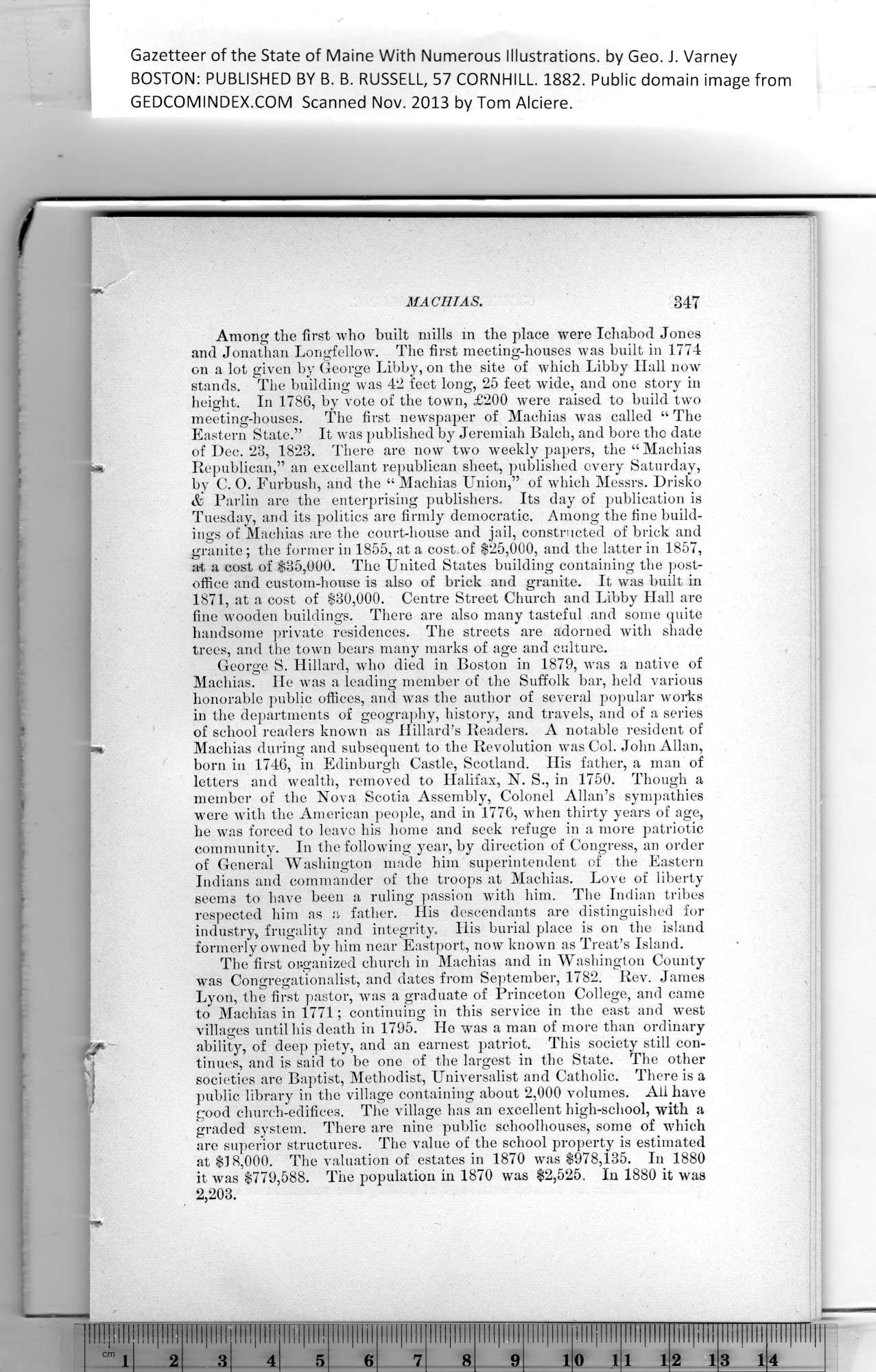|
Gazetteer of the State of Maine With Numerous Illustrations, by Geo. J. Varney
BOSTON: PUBLISHED BY B. B. RUSSELL, 57 CORNHILL. 1882. Public domain image from
MACHIAS. 347
Among the first who built mills in the place were Ichabod Jones
and Jonathan Longfellow. The first meeting-houses was built in 1774
on a lot given by George Libhy, on the site of which Libby Hall now
stands. The building was 42 feet long, 25 feet wride, and one story in
height. In 1786, by vote of the town, £200 were raised to build twro
meeting-houses. The first newspaper of Machias was called “ The
Eastern State.” It was published by Jeremiah Balch, and bore the date
of Dec. 23, 1823. There are now two weekly papers, the “Machias
Republican,” an excellant republican sheet, published every Saturday,
by C. O. Furbush, and the “ Machias Union,” of whicli Messrs. Drisko
Si Parlin are the enterprising publishers. Its day of publication is
Tuesday, and its politics are firmly democratic. Among the fine build-
ings of Machias are the court-house and jail, constructed of brick and
granite; the former in 1855, at a cost.of $25,000, and the latter in 1857,
at a cost of $35,000. The United States building containing the post-
office and custom-house is also of brick and granite. It was built in
1871, at a cost of $30,000. Centre Street Church and Libby Hall are
fine wooden buildings. There are also many tasteful and some quite
handsome private residences. The streets are adorned with shade
trees, and the town bears many marks of age and culture.
George S. Hillard, who died in Boston in 1879, was a native of
Machias. He was a leading member of the Suffolk bar, held various
honorable public offices, and was the author of several popular works
in the departments of geography, history, and travels, and of a series
of school readers known as Hillard’s Readers. A notable resident of
Machias during and subsequent to the Revolution was Col. John Allan,
born in 1746, in Edinburgh Castle, Scotland. His father, a man of
letters and wealth, removed to Halifax, N. S., in 1750. Though a
member of the Nova Scotia Assembly, Colonel Allan’s sympathies
were with the American people, and in 1776, when thirty years of age,
he was forced to leave his home and seek refuge in a more patriotic
community. In the following year, by direction of Congress, an order
of General Washington made him superintendent of the Eastern
Indians and commander of tbe troops at Machias. Love of liberty
seems to have been a ruling passion with him. The Indian tribes
respected him as a father. His descendants are distinguished for
industry, frugality and integrity. His burial place is on the island
formerly owned by him near Eastport, now known as Treat’s Island.
The first organized church in Machias and in Washington County
was Congregationalist, and dates from September, 1782. Rev. James
Lyon, the first pastor, was a graduate of Princeton College, and came
to Machias in 1771; continuing in this service in the east and west
villages until his death in 1795. He was a man of more than ordinary
ability, of deep piety, and an earnest patriot. This society still con-
tinues, and is said to be one of the largest in the State. The other
societies are Baptist, Methodist, Universalist and Catholic. There is a
public library in the village containing about 2,000 volumes. All have
good church-edifices. The village has an excellent high-school, with a
graded system. There are nine public schoolhouses, some of which
are superior structures. The value of the school property is estimated
at $18,000. The valuation of estates in 1870 was $978,135. In 1880
it was $779,588. The population in 1870 was $2,525. In 1880 it was
2,203.
PREVIOUS PAGE ... NEXT PAGE
This page was written in HTML using a program written in Python 3.2
|
